Campbellclanman
Platinum Member
- Joined
- Mar 10, 2007
- Messages
- 15,833
Gorgeous Pick Bone Augue, seeing as you suggested that this maybe Art Deco - that knife must come down here as Sue andI have shifted into THE Art Deco area of NZ 
The BladeForums.com 2024 Traditional Knife is available! Price is $250 ea (shipped within CONUS).
Order here: https://www.bladeforums.com/help/2024-traditional/
Gorgeous Pick Bone Augue, seeing as you suggested that this maybe Art Deco - that knife must come down here as Sue andI have shifted into THE Art Deco area of NZ


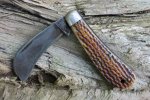
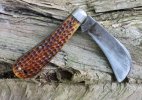
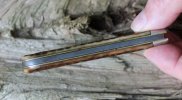
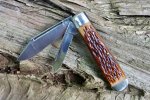
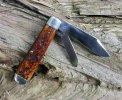
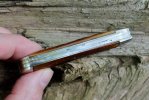
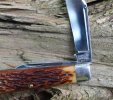
I love it when the back springs take on a dark patina. Nice knives augieAn interesting pair of knives from the same era in todays mail. A well used Case XX green bone pruner, spent a lot of time in someones pocket, spring has turned black from sweat, very sharp and still great snap.
Other is a short line Camillus #12 jack, 3 1/2" and looks to be unused. Can find very few examples of this knife.
View attachment 1887346View attachment 1887347View attachment 1887348View attachment 1887349View attachment 1887350View attachment 1887351View attachment 1887352
I love it when the back springs take on a dark patina. Nice knives augie
Here is Schrade CC Texas Jack (Moose) pattern no. 7813 (Schrade 1926 catalog pg. 46). The catalog says it is 4 inches. I measure
this example at 3 & 15/16 inches. I was drawn to it because of the beautiful pick bone handles and the blade finishes. The clip point mark side blade is crocus finished and all other blade surfaces are glazed. The folder does not look to have been used or sharpened post production.
This jack has spun pins and because of this it is definitely a 1920s or later produced specimen. I think it is generally accepted that in American cutlery hammered pins are pre circa 1920 and spun pins are post circa 1920. The pick bone handles are usually associated with pre 1920 knives.
View attachment 1885407View attachment 1885403View attachment 1885405View attachment 1885404View attachment 1885406View attachment 1885511
Just acquired a very nice Miller Bros sheepsfoot jack, 3 3/8", very little use, all steel construction, wonderful pick bone and a great swedge on the pile side of main blade, to me it looks streamline, aero or Art Deco.
View attachment 1885913View attachment 1885914View attachment 1885915View attachment 1885916
What an incredible piece John! The bone!!!!!!!!Just acquired a very nice Miller Bros sheepsfoot jack, 3 3/8", very little use, all steel construction, wonderful pick bone and a great swedge on the pile side of main blade, to me it looks streamline, aero or Art Deco.
View attachment 1885913View attachment 1885914View attachment 1885915View attachment 1885916
Both very nice JohnAn interesting pair of knives from the same era in todays mail. A well used Case XX green bone pruner, spent a lot of time in someones pocket, spring has turned black from sweat, very sharp and still great snap.
Other is a short line Camillus #12 jack, 3 1/2" and looks to be unused. Can find very few examples of this knife.
View attachment 1887346View attachment 1887347View attachment 1887348View attachment 1887349View attachment 1887350View attachment 1887351View attachment 1887352

The case is a beaut. Person who owned it clearly was attached to it and considerate when sharpening. Nice to see a constant sweep out to the point.An interesting pair of knives from the same era in todays mail. A well used Case XX green bone pruner, spent a lot of time in someones pocket, spring has turned black from sweat, very sharp and still great snap.
Other is a short line Camillus #12 jack, 3 1/2" and looks to be unused. Can find very few examples of this knife.
View attachment 1887346View attachment 1887347View attachment 1887348View attachment 1887349View attachment 1887350View attachment 1887351View attachment 1887352
You're welcome Blake, enjoy it.

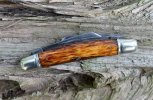
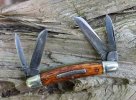
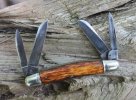
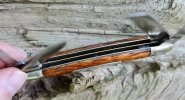
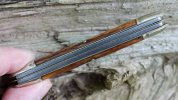
Very cool knife!! I like the bling, and the handles a lot!!A Waterville large Congress, 4 1/8", Waterville in business 1847 to 1913,
Very cool knife!! I like the bling, and the handles a lot!!
Fantastic Schrade!Another grail mail call from
Gorgeous big boy there John.A Waterville large Congress, 4 1/8", Waterville in business 1847 to 1913, with the type of bone I would think late 1800's. Pretty fancy knife, coined liner top and bottom. All blades tang stamped, curved Waterville on the pens and straight line on the larger blades. First Waterville I've been able to add to the collection.
View attachment 1890440View attachment 1890441View attachment 1890442View attachment 1890443View attachment 1890444View attachment 1890445
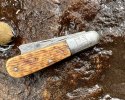
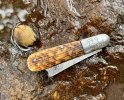
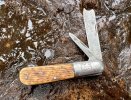
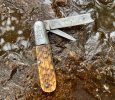
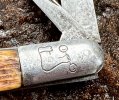
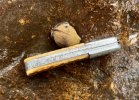
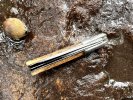
Armstrong Cutlery?Fantastic Schrade!
Gorgeous big boy there John.
I hope y'all can tell me a little about this knife. The only manufacturer I have been able to connect to the "fist holding a dumbbell" is Paul Stommel (Solingen) who manufactured razors and he operated back around 1835 to late 1840's. Someone in Germany must have used Stommel's idea sometime around the early 1900's? Anyway I'm pretty sure I have seen this barlow in a few collections here. Tight with good snap. Unusual bone. All steel.
No mark on main blade. Secondary blade marked - Newport / Cutlery Co / GermanyView attachment 1890689View attachment 1890688View attachment 1890686View attachment 1890685View attachment 1890690View attachment 1890691View attachment 1890692
Yes Rachel I do think it's possible.Do you think it's possible the blade on yours has been replaced
